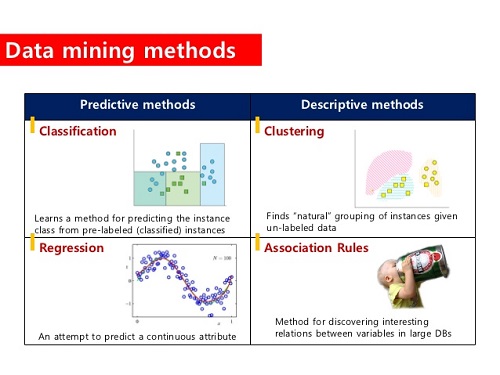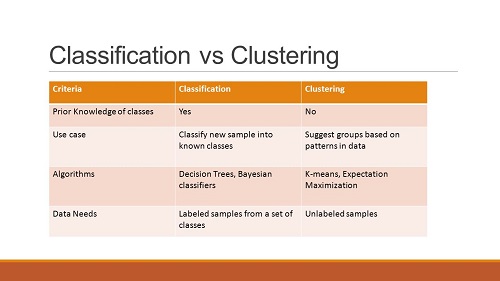Difference between Clustering and Classification
Clustering and classification techniques are used in machine-learning, information retrieval, image investigation, and related tasks.
These two strategies are the two main divisions of data mining processes. In the data analysis world, these are essential in managing algorithms. Specifically, both of these processes divide data into sets. This task is highly relevant in today’s information age as the immense increase of data coupled with development needs to be aptly facilitated.
Notably, clustering and classification help solve global issues such as crime, poverty, and diseases through data science.
What is Clustering?
Basically, clustering involves grouping data with respect to their similarities. It is primarily concerned with distance measures and clustering algorithms which calculate the difference between data and divide them systematically.
For instance, students with similar learning styles are grouped together and are taught separately from those with differing learning approaches. In data mining, clustering is most commonly referred to as “unsupervised learning technic” as the grouping is based on a natural or inherent characteristic.
It is applied in several scientific fields such as information technology, biology, criminology, and medicine.
Characteristics of Clustering:
- No Exact Definition
Clustering has no precise definition that is why there are various clustering algorithms or cluster models. Roughly speaking, the two kinds of clustering are hard and soft. Hard clustering is concerned with labeling an object as simply belonging to a cluster or not. In contrast, soft clustering or fuzzy clustering specifies the degree as to how something belongs to a certain group.
- Difficult to be Evaluated
The validation or assessment of results from clustering analysis are often difficult to ascertain due to its inherent inexactness.
- Unsupervised
As it is an unsupervised learning strategy, the analysis is merely based on current features; thus, no stringent regulation is needed.
What is Classification?
Classification entails assigning labels to existing situations or classes; hence, the term “classification”. For example, students exhibiting certain learning characteristics are classified as visual learners.
Classification is also known as “supervised learning technic” wherein machines learn from already labeled or classified data. It is highly applicable in pattern recognition, statistics, and biometrics.
Characteristics of Classification
- Utilizes a “Classifier”
To analyze data, a classifier is a defined algorithm that concretely maps an information to a specific class. For example, a classification algorithm would train a model to identify whether a certain cell is malignant or benign.
- Evaluated Through Common Metrics
The quality of a classification analysis is often assessed via precision and recall which are popular metric procedures. A classifier is evaluated regarding its accuracy and sensitivity in identifying the output.
- Supervised
Classification is a supervised learning technic as it assigns previously determined identities based on comparable features. It deduces a function from a labeled training set.
Differences between Clustering and Classification
- Supervision
The main difference is that clustering is unsupervised and is considered as “self-learning” whereas classification is supervised as it depends on predefined labels.
- Use of Training Set
Clustering does not poignantly employ training sets, which are groups of instances employed to generate the groupings, while classification imperatively needs training sets to identify similar features.
- Labeling
Clustering works with unlabeled data as it does not need training. On the other hand, classification deals with both unlabeled and labeled data in its processes.
- Goal
Clustering groups objects with the aim to narrow down relations as well as learn novel information from hidden patterns while classification seeks to determine which explicit group a certain object belongs to.
- Specifics
While classification does not specify what needs to be learned, clustering specifies the required improvement as it points out the differences by considering the similarities between data.
- Phases
Generally, clustering only consists of a single phase (grouping) while classification has two stages, training (model learns from training data set) and testing (target class is predicted).
- Boundary Conditions
Determining the boundary conditions is highly important in the classification process as compared to clustering. For instance, knowing the percentage range of “low” as compared to “moderate” and “high” is needed in establishing the classification.
- Prediction
As compared to clustering, classification is more involved with prediction as it particularly aims to identity target classes. For instance, this may be applied in “facial key points detection” as it can be used in predicting whether a certain witness is lying or not.
- Complexity
Since classification consists of more stages, deals with prediction, and involves degrees or levels, its’ nature is more complicated as compared to clustering which is mainly concerned with grouping similar attributes.
- Number of Probable Algorithms
Clustering algorithms are mainly linear and nonlinear while classification consists of more algorithmic tools such as linear classifiers, neural networks, Kernel estimation, decision trees, and support vector machines.
Clustering vs Classification: Table comparing the difference between Clustering and Classification
| Clustering | Classification |
| Unsupervised data | Supervised data |
| Does not highly value training sets | Does highly value training sets |
| Works solely with unlabeled data | Involves both unlabeled and labeled data |
| Aims to identify similarities among data | Aims to verify where a datum belongs to |
| Specifies required change | Does not specify required improvement |
| Has a single phase | Has two phases |
| Determining boundary conditions is not paramount | Identifying the boundary conditions is essential in executing the phases |
| Does not generally deal with prediction | Deals with prediction |
| Mainly employs two algorithms | Has a number of probable algorithms to use |
| Process is less complex | Process is more complex |
Summary on Clustering and Classification
- Both clustering and classifying analyses are highly employed in data mining processes.
- These techniques are applied in a myriad of sciences which are essential in solving global issues.
- Mostly, clustering deals with unsupervised data; thus, unlabeled whereas classification works with supervised data; thus, labeled. This is one of the major reasons why clustering does not need training sets while classification does.
- There are more algorithms associated with classification as compared to clustering.
- Clustering seeks to verify how data are similar or dissimilar among each other while classification focuses on determining data’s “classes” or groups. This makes the clustering process more focused on boundary conditions and the classification analysis more complicated in the sense that it involves more stages.
- Difference Between Hematoma and Melanoma - February 9, 2023
- Difference Between Bruising and Necrosis - February 8, 2023
- Difference Between Brain Hematoma and Brain Hemorrhage - February 8, 2023
Search DifferenceBetween.net :
Leave a Response
References :
[0]Goswami, Jyotismita. “A Comparative Study on Clustering and Classification Algorithms”. International Journal of Scientific Engineering and Applied Sciences 1.3 (2015): 170-178. Print.
[1]King, Ronald. Cluster Analysis and Data Mining: An Introduction. Boston: Mercury Learning and Information, 2014. Print.
[2]Wang, Halgamuge. Classification and Clustering for Knowledge Discovery. New York: Springer, 2005. Print.
[3]"Image Credit: https://stackoverflow.com/questions/5064928/difference-between-classification-and-clustering-in-data-mining"


